NATIONAL ZOO AND CONSERVATION BIOLOGY INSTITUTE
How Do You Help a Gorilla With a Toothache?
Western lowland gorilla Baraka is serious about food. When keepers noticed he wasn’t eating, they wondered if his change in appetite masked something more serious.
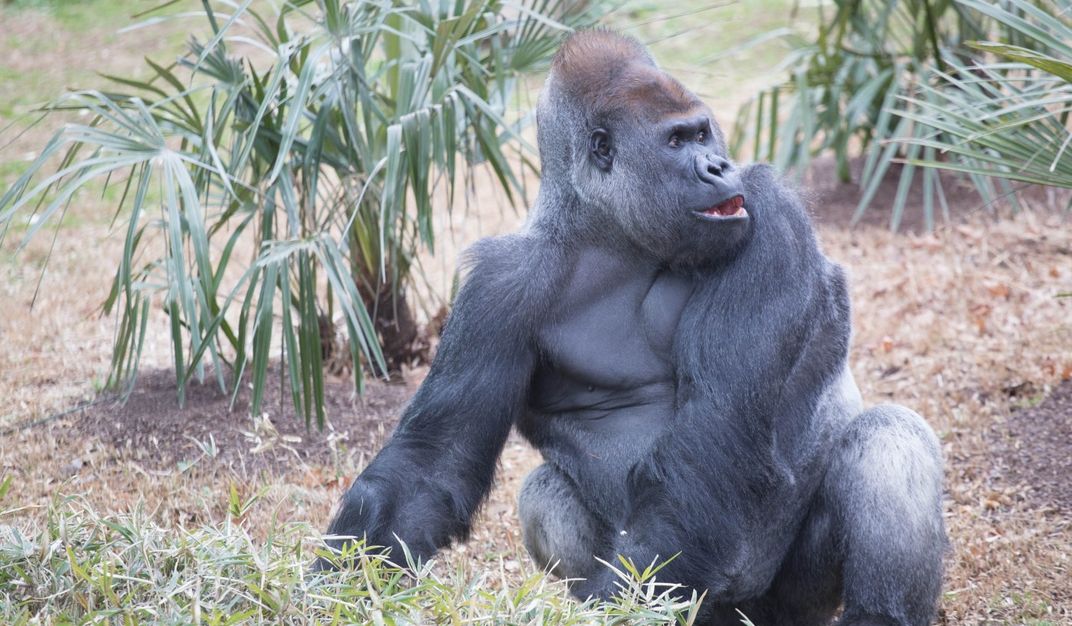
Those who regularly follow the Smithsonian’s National Zoo’s #GorillaStory know that our updates typically center around Moke, our rambunctious 2-year-old western lowland gorilla. For this particular update, though, I am turning the spotlight on his father, Baraka, our 28-year-old silverback.
This story begins in late summer 2020. Baraka and his troop — Calaya, Moke, Mandara and Kibibi — had spent much of the day outside foraging and exploring their habitat. The primate team called the gorillas indoors for their afternoon feeding. As we gave each gorilla his or her meal, keeper Carly Hornberger noticed something odd: Baraka wasn’t showing any interest in eating his food.
In some animals, a little disinterest in food is not a big deal. However, anyone who knows Baraka knows he is serious about food. The dietary snub was out of character for our 400-pound silverback and gave us some cause for concern.
Luckily, Baraka is trained to voluntarily participate in his own health care. Our gorillas present body parts on cue, for example, when asked by a keeper. They are then rewarded for doing the correct behavior, usually with a favorite food — such as grapes or peanuts — and an emphatic “good job!” We conduct these husbandry training sessions with our primates daily to check for any unusual issues that may require veterinary attention.
Carly called Baraka over to the mesh and asked him to present his ear so that she could take his temperature with a thermometer, but he was not interested in participating. She looked for any outward signs of illness. He didn’t have a runny nose, and was not sneezing or coughing. Overall, though, he just looked uncomfortable and was lying down more than usual.
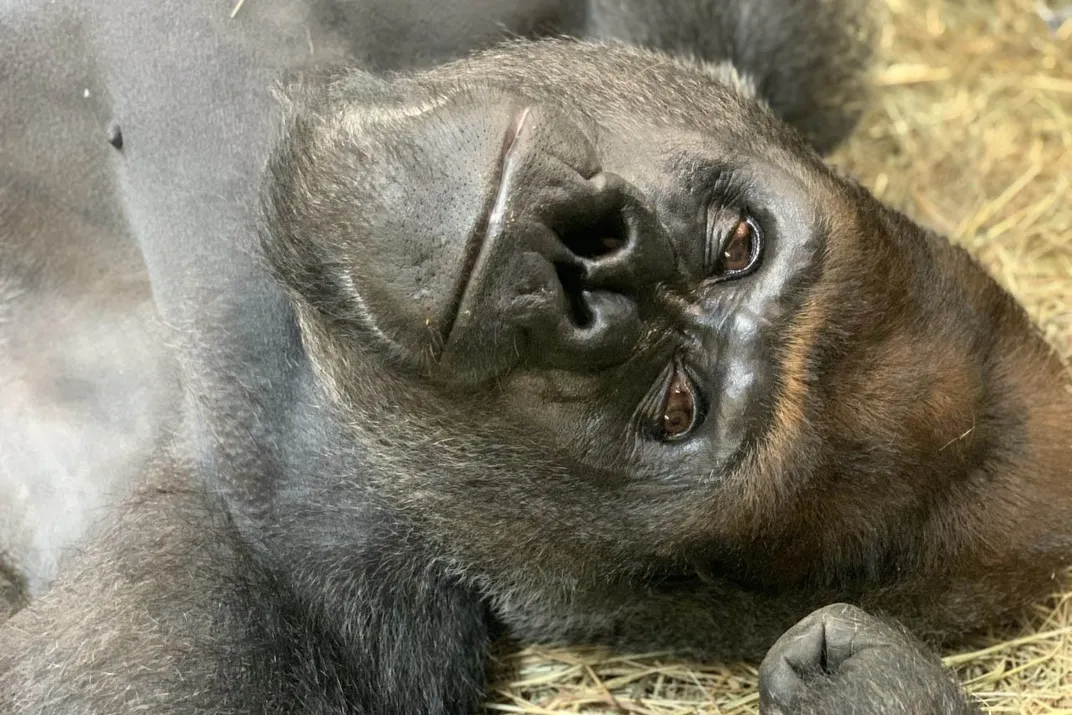
The next morning when we gave the troop their diets, Baraka ate normally. We were cautiously optimistic that his bout of inappetence was just an isolated occurrence.
Then, on Oct. 8 after Baraka spent much of the day foraging on browse (leafy branches), he once again exhibited an unusual disinterest in food. He also laid down frequently and changed positions often, which are signs of abdominal discomfort.
Following Baraka’s second episode of inappetence, the primate team consulted with the Zoo’s Department of Wildlife Health Sciences — our veterinary team. During these consultations, a vet may come to the Great Ape House and observe our great apes during their training sessions. Since our veterinarians are able to conduct visual and even hands-on examinations at these times, it reduces the need to place our primates under anesthesia. Our gorillas are trained to participate in ultrasounds, electrocardiograms and other medical behaviors — all while awake.
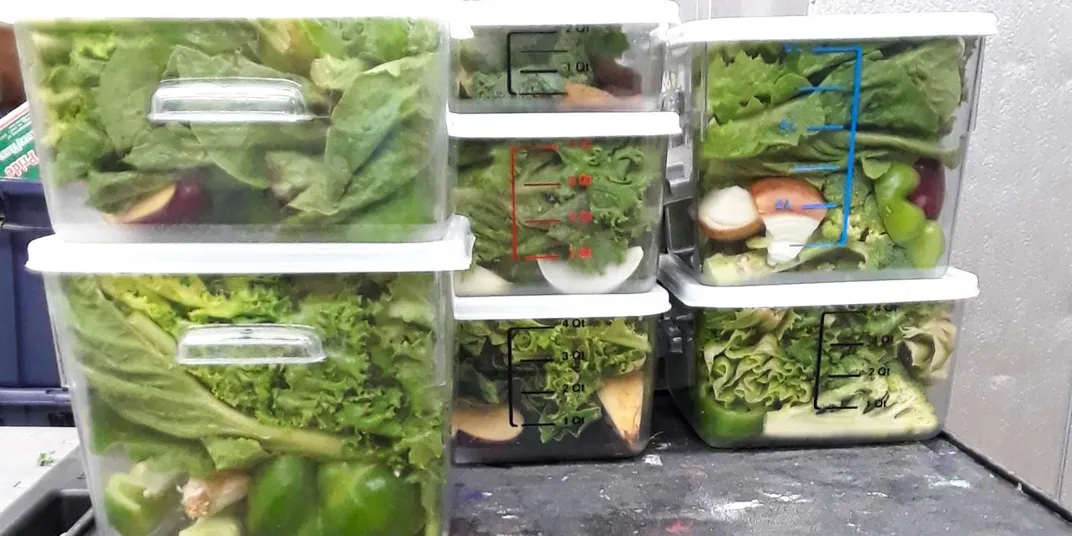
Although these exams cover many areas of interest, they do not cover all of them. Sometimes, the best way to get a complete and comprehensive exam on an animal involves anesthetizing him or her. In Baraka’s case, we collectively determined that this was the best course of action, and set an exam date for mid-November.
From a keeper perspective, our next steps were clear: make sure Baraka’s upcoming exam goes as smoothly and stress-free for everyone involved — humans and animal alike. One way we prepare our great apes for exams like this is through positive reinforcement. Working closely with our animals helps build trust between us. We ask them to do a behavior and, when they do it, they know a reward is coming.
Training our apes on a routine basis helps us maintain those trusting relationships. Think of it like a bank account: you have to maximize your deposits while minimizing withdrawals. A deposit might be Baraka presenting his ear so we can take his temperature. It’s a simple, straightforward behavior and he gets a reward for completing it. When it comes to the withdrawal trainings that may be unpleasant — like a needle stick — we go the extra mile to make it worth their while. Honey is one such extra special reward, and it is only given during injection training sessions. For many of our apes, the momentary discomfort from the prick of a needle is well worth the delicious reward that follows.
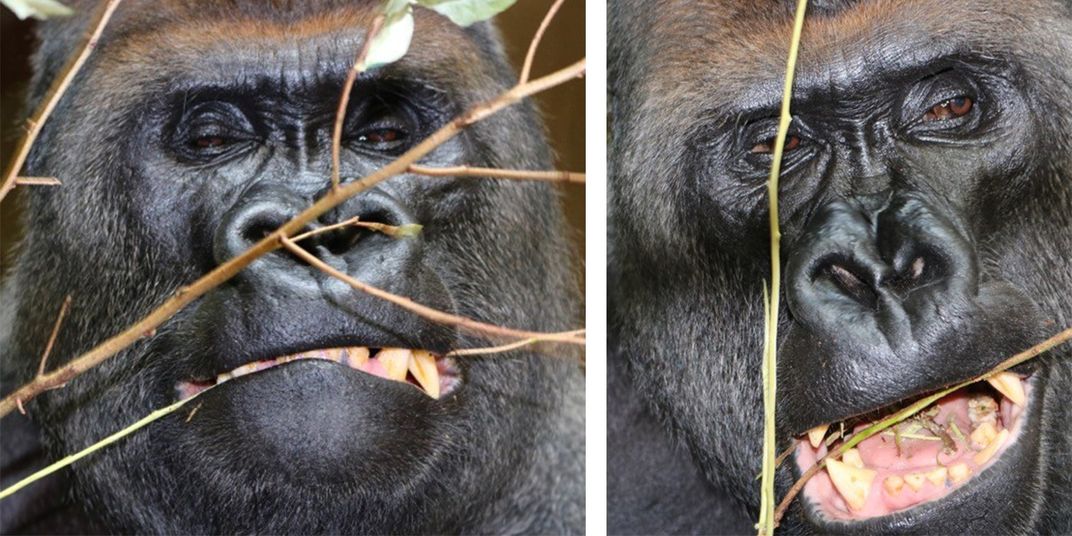
With great apes, practice makes perfect. First, we needed Baraka to willingly and consistently separate from his troop each morning at the scheduled exam time. He shifted into the enclosure, participated in a quick training session, received some big food rewards and was immediately reunited with his troop. During the training sessions, Baraka was asked to present his arm for a syringe and needle with a blunted tip. He and I did this training almost every day leading up to his exam. Practicing this medical behavior consistently helped to build our trust bank.
Just like our doctors would ask us to do, our great apes fast before a procedure to reduce the risk of vomiting under anesthesia. Keepers do not give them anything to eat after a certain time, and we turn off their water sources at the end of the night. The apes are so smart that we need them to fast occasionally even when no exam is scheduled. Otherwise, on exam days they notice that the water is off and it makes them suspicious.
On the day of the exam, Nov. 12, all of our preparation was put to the test. As we had practiced, Baraka separated from his troop, presented his arm at the mesh, and I injected him with the anesthesia. Unlike saline, the anesthetic drugs sting. Baraka noticed the sensation right away, and gave me a not-so-pleased throw of his arm in my direction. Within minutes, he was asleep in his enclosure, and the veterinarians, veterinary technicians and primate team moved quickly together to transport him to the Zoo’s Vet Hospital.
While our veterinary team are able to treat the vast array of species at the Zoo, some exams and procedures call for extra expertise. Having specialists at an animal’s exam while it is under anesthesia can proactively reduce the need for a second anesthetic event. After our vets completed Baraka’s workup — X-rays, bloodwork, an ultrasound and a physical exam — the specialists were called in to perform their own diagnostics.
Dr. Steven Rosenthal, a veterinary cardiologist, performed a cardiac ultrasound to check the function of Baraka’s heart. All great apes, including humans, are at risk for cardiac disease. Thankfully, Baraka’s cardiac exam was normal.
Next up was Dr. Steven Zeddun, a gastroenterologist, and Dr. Khashayar Vaziri, a general surgeon, both from George Washington University. Dr. Vaziri evaluated a previously noted umbilical hernia to make sure that this was not the cause of Baraka’s discomfort. Dr. Zeddun performed an upper gastrointestinal endoscopy and endoscopic ultrasound to check the structures of Baraka’s gastrointestinal system. Once again, we received good news: all structures appeared within normal limits.
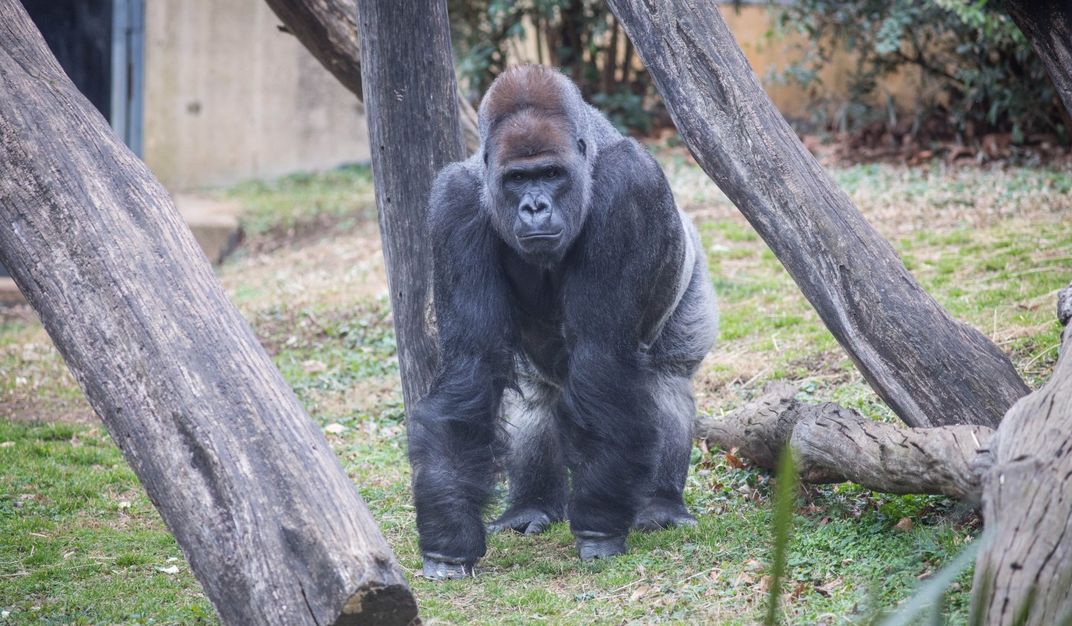
But it still left the question unanswered: what was the cause of his symptoms?
During Baraka’s intubation — the procedure in which a tube is placed down his trachea to administer anesthesia while the exam is underway — the doctors noticed a growth on Baraka’s gumline and some infected teeth. Since the other specialized tests did not point to a source of the discomfort, we wondered if this growth and infection might be the cause. They biopsied the area of concern to determine if the growth was just an infection or something much more worrisome, like a tumor.
Although we had hoped only one exam under anesthesia would be necessary, it was clear that Baraka would need another procedure — with a dentist, this time — to address the growth. I made a huge withdrawal from the trust account during Baraka’s last exam, and regaining his trust to be separated again and take an injection would require a big effort on both our parts. And I only had a few weeks to prepare Baraka for his follow-up exam.
Right after his first exam, Baraka started antibiotics. About a week after the procedure, we received the biopsy results from Baraka’s gum biopsy, and there was more good news. The results confirmed that the area in question was inflamed due to his infected teeth; there was no tumor. It was a huge relief to our entire team!
Regaining Baraka’s trust took a little bit of time, and some big food rewards. Whole wheat bread — a very novel treat — was the ticket this time. The way to a man’s heart is through his stomach, as the saying goes. That seems to be the case for silverback gorillas, too! Baraka overcame his wariness, and we were on track for his next exam.
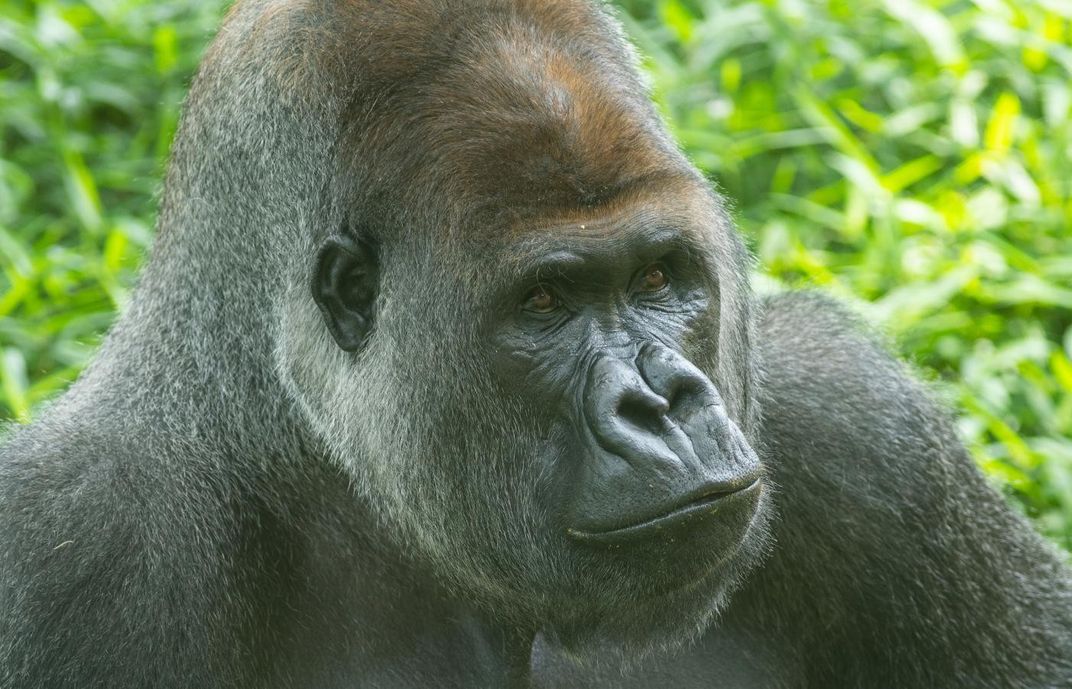
On Dec. 23, Baraka voluntarily separated from his troop and received an injection of anesthesia. Since we had already conducted his routine tests, we did not need to transport him to the Vet Hospital. Instead, a consulting veterinary dentist, Dr. Barron Hall, came to the Great Ape House and extracted Baraka’s four infected teeth inside the enclosure. It took some special dentistry equipment — and a lot of muscle — but the procedure went well.
Once Baraka fully recovered from anesthesia, he was reunited with his troop. He immediately laid down, propped his feet up, and took a long nap. In the days that followed, we kept a close eye on Baraka. He received antibiotics and pain medications in his morning cup of yogurt, and we fed him softened foods to make chewing a bit easier.
Remarkably, he ate normally again just a few days after his dental procedure, as if nothing had happened. Now that those teeth have been removed and the infection cleared, he should not experience further problems. We will continue to keep an eye on his mouth, but he should need no further treatment.
It has been a rollercoaster of emotions throughout Baraka’s mysterious ailment, but I am grateful to everyone — my primate team members, our veterinary team and the local specialists — whose expertise enabled us to successfully diagnose and treat Baraka’s infection. Now, he’s back to being his old self, eating, napping, playing with Moke and keeping a close eye on his troop!
This story appears in the March 2021 issue of National Zoo News. Our whole team works diligently to care for our animals and keep you connected to the Zoo. With your support, our conservation mission continues. If you can, please join us in this important work by making a donation today. On behalf of the animals we care for and work to protect: thank you.
The Smithsonian’s National Zoo is temporarily closed to help prevent the spread of COVID-19.


